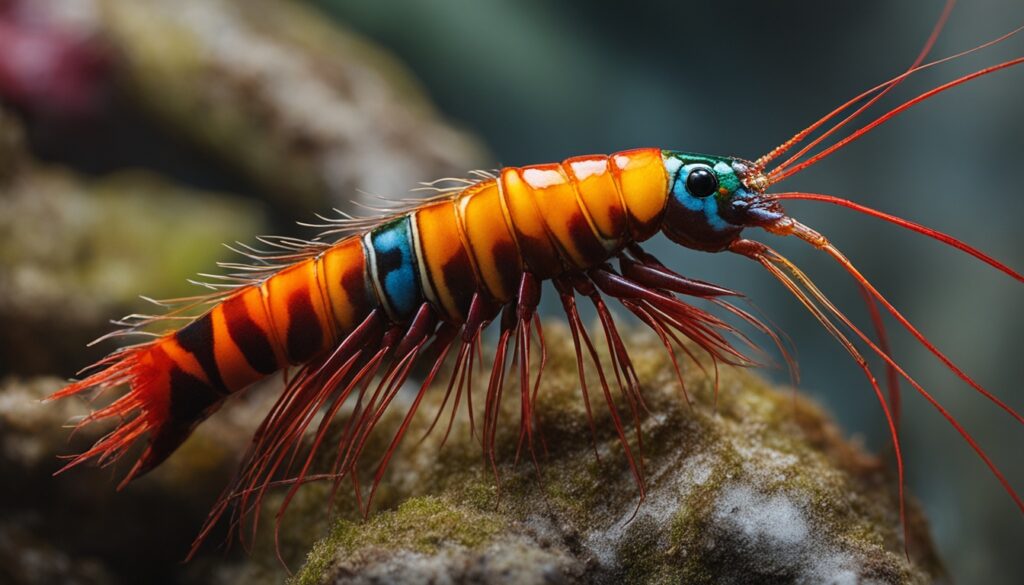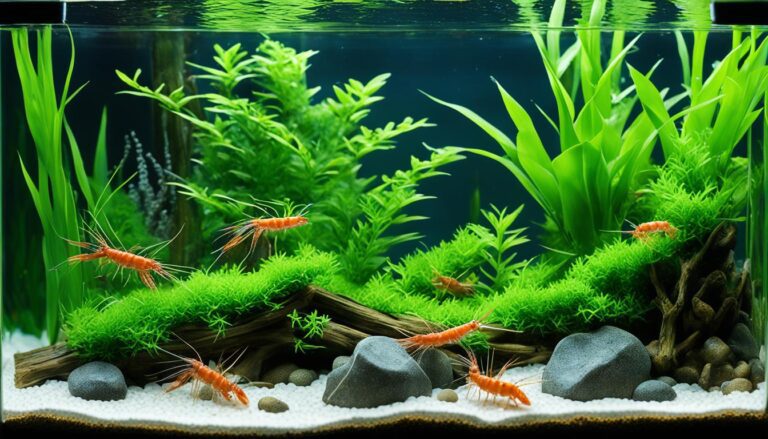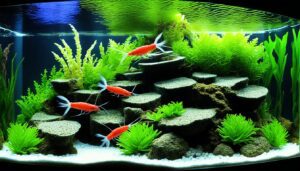Hey there, fellow fish lovers! Today, I want to introduce you to one of the coolest little critters for your tank – the Bamboo Shrimp, also known as Atyopsis moluccensis. These guys are freshwater filter feeders from Southeast Asia, and they’re perfect if you’re into something a bit more exotic. Plus, they’re super peaceful, which makes them an awesome addition to any aquarium.
So, let’s talk size first. Bamboo Shrimp can grow up to around 3 inches long. With the right care, they’ll hang around your tank for about two years, and if you’re lucky, maybe even longer!
When it comes to setting up their space, a good-sized tank is a must. These shrimp need at least a 20-gallon tank so they have room to move around. Keep the water temp between 71-82°F and make sure the pH stays in that sweet spot of 6.5 to 7.5. Oh, and don’t forget to keep an eye on the water’s hardness and carbonate hardness levels too.
Now, breeding these little guys can be a bit tricky. The babies actually need brackish water (a mix of fresh and saltwater) to survive, so it takes some extra effort and patience. But hey, if you’re up for the challenge, it’s definitely rewarding!
As for feeding, Bamboo Shrimp thrive on tiny particles like plant debris and micro-algae. Every couple of months, they go through a molting phase, which is totally normal. They also play nice with a lot of other fish, so they fit right in with most community tanks.
In short, Bamboo Shrimp are an awesome choice if you’re looking for a peaceful, hardworking addition to your aquarium. They’re not just beautiful to look at, but they also help keep your tank clean and balanced. So, why not give them a shot? Your tank will be all the better for it!
Bamboo Shrimp Species Profile

Bamboo shrimp are such a fascinating find from Southeast Asia! Known for their cool, fan-like feeding technique, these little invertebrates sift through water currents to catch their food, making them a fun and unique addition to any freshwater aquarium. Whether you’re a seasoned aquarist or just starting out, these shrimp bring a whole new level of interest to your tank.
When it comes to tank mates, Bamboo Shrimp do best in a peaceful environment. They’re super calm and get along well with other chill fish and shrimp. If you’re building a community tank, they’re an awesome choice for maintaining harmony among your aquatic buddies.
Their red-brown color and the way they use their fans to feed is something you’ll never get tired of watching. It’s mesmerizing to see them gracefully move through the water while they feed. To make them feel right at home, it’s a good idea to set up fast currents in your tank and offer plenty of hiding spots so they can feel secure.
For anyone deciding which shrimp species to add to their tank, I’ve compared a few different options below. This guide is perfect for beginners looking to expand their aquarium or experienced aquarists trying to mix things up.
Shrimp Species |
Size (inches) |
Typical Eggs per Breeding |
Special Features |
Conservation Status |
|---|---|---|---|---|
Bamboo Shrimp |
Up to 3 |
N/A |
Fan hands for filter feeding |
Least Concern |
Sulawesi Shrimp |
Up to 1 |
15 |
Vibrant color patterns |
Not Listed |
Up to 6 |
N/A |
Enlarged second pair of claw bones |
Not Listed |
|
Opae Ula Shrimp |
N/A |
N/A |
Needs specific tank salinity (1.008 to 1.018 sg) |
Not Listed |
By embracing the bamboo shrimp and their needs, you can create a thriving aquarium. Their peaceful nature and unique feeding habits make them a great choice for diversifying your aquatic community. They bring a sense of calm and exotic beauty to any tank.
Bamboo Shrimp Size and Lifespan Factors

Welcome to an up-close look at the Bamboo Shrimp, or Atyopsis moluccensis. In this section, we’ll dive into their size and lifespan so you can better care for these intriguing little creatures.
Identifying Bamboo Shrimp
Bamboo Shrimp are real eye-catchers thanks to their unique colors and patterns. They grow anywhere from 2.5 to 5 inches long (about 6 to 13 cm), with a reddish-brown body that has subtle horizontal stripes, almost like wood grain. These stripes make them easy to spot, even in a tank bustling with different fish.
They’re peaceful but definitely stand out because of their size and striking appearance. If you’re ever unsure of the species, just take a closer look at their rostrum—the pointed part of their head. Atyopsis moluccensis has between 7 and 16 little “teeth” underneath the rostrum, which helps distinguish them from other similar shrimp.
Life Expectancy
Understanding their lifespan is key to keeping your Bamboo Shrimp happy and healthy. Typically, they live for about 1 to 2 years, but with excellent care, they can sometimes reach 3 years. Things like water quality, tank size, and a well-balanced diet all play a big role in how long they’ll thrive in your aquarium.
Parameter |
Ideal Condition |
|---|---|
Size |
2.5 to 5 inches |
Lifespan |
1 to 3 years |
Water Temperature |
72-82°F (22-28°C) |
pH Level |
6.5-7.5 |
Water Hardness |
5-20 dGH |
Minimum Tank Size |
20 gallons per shrimp |
To keep bamboo shrimp happy, maintain the right conditions in their tank. Watching them filter feed with their fan-like appendages is rewarding. It shows they are healthy and happy.
To make sure your bamboo shrimp live a long life, focus on proper care. Understand their needs and create a good home for them in your aquarium.
Essential Bamboo Shrimp Care: Tank Setup and Water Requirements
Starting your bamboo shrimp care journey means getting the aquarium set up just right and keeping an eye on water quality. These freshwater filter feeders, Atyopsis moluccensis, need a specific environment to truly thrive. Here’s how you can create the perfect bamboo shrimp habitat.
Creating the Ideal Bamboo Shrimp Habitat
First things first—your bamboo shrimp will need a tank that’s at least 20 gallons. This gives them plenty of space to move around and be social, which is super important because they like to hang out in groups. A larger tank not only keeps them happy but also makes it easier to spot them as they go about their day.
To mimic their natural Southeast Asian habitat, you’ll want flowing water and good oxygen levels. A strong filter is essential for keeping the tank clean, but be careful not to create a current that’s too strong—it shouldn’t stop them from comfortably feeding from the water.
Water Parameters
Getting the water conditions right is key to keeping your shrimp healthy. The water temperature should stay between 68° and 77°F, with a pH range of 7.0 to 8.0. Water hardness is also important, so aim for a hardness level of 6-10 and carbonate hardness between 3-6. Maintaining these conditions helps your shrimp act naturally and stay healthy, almost like you’re bringing a little piece of their home into your tank.
Decor and Plant Considerations for Bamboo Shrimp Comfort
When it comes to plants and decor, it’s all about giving your shrimp plenty of places to hide and feed. Plants like java fern, anubias, and moss balls work great for creating little hideouts. Adding some driftwood and rocks will not only make the tank look natural but also keep your shrimp feeling cozy.
With the right setup and care, your bamboo shrimp will thrive, and watching them will become even more rewarding. They’re peaceful creatures that add so much life to any aquarium, and with a bit of attention to detail, you’ll enjoy their company for a long time.
Feature |
Requirement |
Benefit |
|---|---|---|
Tank Size |
Minimum 20 gallons |
Provides ample space for group dynamics and natural behavior |
Water Flow |
Moderate to strong |
Supports filter feeding and oxygenation |
Plants and Decor |
Varied, including live plants and natural decor |
Enhances aesthetic, provides hiding and feeding spots |
Water Parameters |
68°-77°F, pH 7.0-8.0 |
Maintains health and mimics natural habitat |
Breeding Bamboo Shrimp: Challenges and Insights

Breeding bamboo shrimp in a home aquarium is definitely a bit of a challenge, but with some careful planning and patience, it’s possible. These shrimp have a unique life cycle, with adults living in freshwater and their larvae needing brackish water to develop, which adds some complexity to the process.
Identifying the Sex of Bamboo Shrimp
The first step in breeding is figuring out which shrimp are male and which are female. Females tend to have larger abdomens and longer tail appendages, while males are slimmer and have smaller front claws. Once you can tell them apart, you’re ready to create the right breeding environment.
The Freshwater-to-Brackish Transition
One of the toughest parts of breeding bamboo shrimp is the transition between freshwater and brackish water. You’ll need a freshwater tank for the adults to breed, and you’ll need to monitor the water quality closely throughout. Once breeding happens, it’s time to get a brackish tank ready for the larvae. This transition is key, but it’s also where things get tricky. Proper water management is crucial to help the larvae survive and thrive.
Here’s what to keep in mind:
- Monitor water quality constantly, both for the adults and the larvae.
- Adjust feeding habits since the larvae will need different food than the adults.
- Master the balance between mixing freshwater and brackish environments.
The Challenge of Bamboo Shrimp Breeding
There’s still a lot we don’t fully understand about bamboo shrimp, especially their breeding habits. That makes the process a bit experimental for hobbyists. Scientists and aquarists are still learning about their preferences and behaviors, which adds to the challenge.
Despite the difficulties, breeding bamboo shrimp can be incredibly rewarding for those willing to put in the effort. It’s not only a chance to better understand this fascinating species, but it also deepens your connection to the aquatic world.
Feeding Bamboo Shrimp: Diet and Nutrition Essentials

The way bamboo shrimp eat is pretty mesmerizing. Their filter-feeding behavior isn’t just fun to watch—it’s also vital for their survival. In the wild, they use their fan-like appendages to catch tiny particles and organic matter from the water, which helps them both feed and keep the water clean.
Understanding Bamboo Shrimp’s Filter-Feeding Behavior
Bamboo shrimp typically find a spot with good water flow, extend their fans, and let the water pass through, catching any tiny particles floating by. Their diet mainly consists of microscopic organisms and debris, which they scoop up with those fan-like appendages. To replicate this in your tank, you’ll need to keep the water moving so food particles stay suspended in the water, ensuring your shrimp have a steady stream of food to filter through.
Supplemental Feeding for Bamboo Shrimp
Even though they’re efficient filter feeders, bamboo shrimp might need a little extra help with food in captivity. Offering small, fine foods like spirulina powder, baby brine shrimp, or finely crushed fish flakes can make a big difference. It’s best to add these supplements near the shrimp or by the filter outlet, where the water flow will naturally bring the food to them.
One thing to keep an eye on is how well your shrimp are feeding. If they’re often at the bottom of the tank scavenging, it could be a sign that they’re not getting enough food through filter feeding alone. In this case, you may need to adjust the water flow or increase the amount of food. Just be cautious not to overfeed, as this can mess with the water quality and throw off the balance in your tank.
By giving your bamboo shrimp the right diet and environment, you’ll help them thrive and bring a unique dynamic to your aquarium. Their feeding habits are not only fascinating but also highlight how connected they are to their surroundings.
Best Tank Mates for Bamboo Shrimp
Choosing the right tank mates is crucial for creating a peaceful, thriving aquarium community with bamboo shrimp. These shrimp, which grow to about 2-3 inches, are calm and do well with a variety of tank mates. For instance, Lori had a 55-gallon tank with Serpae Tetras, Black Skirt Tetras, and Ghost Shrimp, which shows how easily different species can live together.
Good tank mates for bamboo shrimp include snails or small, peaceful fish like Rasboras and Corydoras catfish. These species are gentle and won’t bother the shrimp, which is important since bamboo shrimp are pretty sensitive. The shrimp feed on tiny particles, so having a calm environment helps them stay stress-free and focused on feeding.
To make sure they’re well-fed, keep the water flowing fast enough for them to catch food, and if needed, add a bit of spirulina mix or other supplements. Once bamboo shrimp find a spot they like, they’ll stick to it, so creating a stable environment with plenty of hiding spots and the right water conditions will help them feel at home.
Adding Ghost Shrimp can also help balance out the tank, but keep an eye on interactions, especially when your bamboo shrimp are molting, as they can be more vulnerable during that time. A spacious tank with decorations, plants, and good water flow makes for a safe and happy home for all your aquatic friends.








